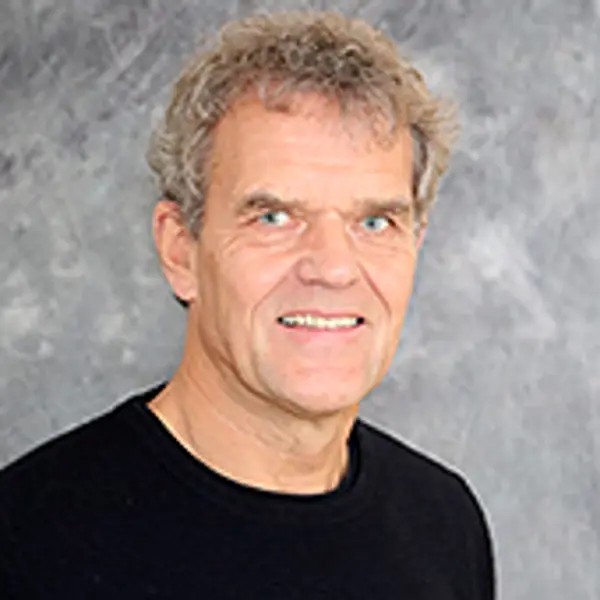Michael Olberg
Michael tog sin doktorsexamen på universitetet i Köln, Tyskland, och jobbade sedan två och ett halvt år vid SEST i Chile innan han fick anställning på den nationella anläggningen på Onsala. På senare år har Michael varit inblandat i arbetet med den svenska satelliten Odin samt HIFI instrumentet på ESA's Herschel satellit.

Visar 99 publikationer
SKA Science Data Challenge 2: analysis and results
Versatile Radiometric Testbed for the Submillimeter Wave Instrument
SEPIA345: A 345 GHz dual polarization heterodyne receiver channel for SEPIA at the APEX telescope
Radio observatories and instrumentation used in space weather science and operations
Vibrationally excited water emission at 658 GHz from evolved stars
SEPIA - A new single pixel receiver at the APEX telescope
Data processing pipeline for Herschel HIFI
Odin observations of ammonia in the Sgr A +50 km s-1 cloud and circumnuclear disk
Simultaneous 183 GHz H2O maser and SiO observations towards evolved stars using APEX SEPIA Band 5
Extragalactic Water Megamasers using ALMA Band 5
Detection of 183 GHz H2O megamaser emission towards NGC 4945
Herschel celestial calibration sources
The effect of sideband ratio on line intensity for Herschel/HIFI
In-orbit performance of Herschel-HIFI
Odin space telescope monitoring of water vapor in the stratosphere of Jupiter
Herschel observations of the Herbig-Haro objects HH52-54
Origin of the hot gas in low-mass protostars Herschel-PACS spectroscopy of HH 46
Hydrides in young stellar objects: Radiation tracers in a protostar-disk-outflow system
Herschel spectral surveys of star-forming regions. Overview of the 555-636 GHz range
Water vapor toward starless cores: The Herschel view
Water in massive star-forming regions: HIFI observations of W3 IRS5
HIFI observations of water in the atmosphere of comet C/2008 Q3 (Garradd)
Water in low-mass star-forming regions with Herschel. HIFI spectroscopy of NGC 1333
Herschel/HIFI deepens the circumstellar NH3 enigma
The first spectral line surveys searching for signals from the dark ages
Herschel-PACS spectroscopy of the intermediate mass protostar NGC 7129 FIRS 2
Sensitive limits on the abundance of cold water vapor in the DM Tauri protoplanetary disk
Water abundance variations around high-mass protostars: HIFI observations of the DR21 region
Water abundances in high-mass protostellar envelopes: Herschel observations with HIFI
Herschel observations of the hydroxyl radical (OH) in young stellar objects
Herschel observations of deuterated water towards Sgr B2(M)
Ortho-to-para ratio of interstellar heavy water
Water cooling of shocks in protostellar outflows Herschel-PACS map of L1157
Herschel/HIFI In-flight commissioning and performance
The Herschel-Heterodyne Instrument for the Far-Infrared (HIFI)
Detection of OH+ and H2O+ towards Orion KL
Herschel/HIFI spectroscopy of the intermediate mass protostar NGC 7129 FIRS 2
Herschel/HIFI observations of high-J CO lines in the NGC 1333 low-mass star-forming region
Variations in H2O+/H2O ratios toward massive star-forming regions
Ground-state ammonia and water in absorption towards Sgr B2
The chemical composition of 9P/tempel 1 from radio observations
Water and ammonia abundances in S140 with the Odin satellite
Odin observations of water in molecular outflows and shocks
Observation of water vapor in the stratosphere of Jupiter with the Odin space telescope
A Swedish heterodyne facility instrument for the APEX telescope
HIFI stability as measured during ILT phase
Odin observations of the Galactic centre in the 118-GHz band. Upper limit to the 02 abundance
Molecular oxygen in the p Ophiuchi cloud
Submillimetre observations of comets with Odin: 2001 - 2005
Global observations of middle atmospheric water vapour by the Odin satellite: An overview.
Upper limits to the water abundance in starburst galaxies
Detection of CS emission towards Cygnus OB2 No. 12
Radio observations of Comet 9P/Tempel 1 before and after Deep Impact
The structure of the cometary globule CG 12:a high-latitude star-forming region
Facility Heterodyne Receiver for the Atacama Pathfinder Experiment Telescope
Radio observations of Comet 9P/Tempel 1 before and after Deep Impact
On the progress in Odin´s hunt for molecules
Odin/SMR Limb Observations of Trace Gases in the Polar Lower Stratosphere during 2004-2005
APEX - The Atacama Pathfinder Experiment
Odin spectral line observations of Sgr A and Sgr B2 at submm wavelengths and in the 118-GHz band
A 0.8 mm heterodyne facility receiver for the APEX telescope
Heterodyne Single-Pixel Facility Instrumentation for APEX Telescope
Odin * CO and 13CO J=5-4 mapping of Orion KL - a step towards accurate water abundances
Odin/SMR limb observations of stratospheric trace gases: Validation of N2O
The diffuse clouds towards Cyg OB2 No. 5 and No. 12
Polar Vortex Evolution during the 2002 Antarctic Major Warming as Observed by the Odin Satellite
Wide-band observations of the 557 GHz water line in Mars with Odin
Recent astroomy highlights from the Odin satellite
Searching for O2 in the SMC: Constraints on Oxygen Chemistry at Low Metallicities
Comparisons of MIPAS/ENVISAT ozone profiles with SMR/ODIN and HALOE/UARS observations
Odin/SMR Observations of Stratospheric Water Vapour and its Isotopes: Requirements on Spectroscopy
New astronomy results from the Odin satellite
Odin/SMR global measurements of water vapour and its isotopes in the stratosphere and the mesosphere
The Odin satellite - I. Radiometer design and test
Odin water mapping in the Orion KL region
The discovery of clumpy structure in the diffuse gas towards Cyg OB2 No. 12
Ladda ner publikationslistor
Du kan ladda ner denna lista till din dator.
Filtrera och ladda ner publikationslista
Som inloggad användare hittar du ytterligare funktioner i MyResearch.
Du kan även exportera direkt till Zotero eller Mendeley genom webbläsarplugins. Dessa hittar du här:
Zotero Connector
Mendeley Web Importer
Tjänsten SwePub erbjuder uttag av Researchs listor i andra format, till exempel kan du få uttag av publikationer enligt Harvard och Oxford i .RIS, BibTex och RefWorks-format.
Visar 1 forskningsprojekt
From the beginning to the end of planetary systems: their birth, life and death